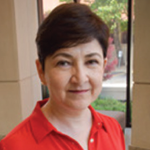A new study in Arthritis Care & Research highlights potential differences in incidence, the presentation of prominent symptoms and laboratory findings in African Americans and Native Americans with Sjögren’s syndrome compared with white populations. Native Americans appear to be at higher risk of the disease, although they often display fewer of the classic symptoms. Importantly, findings suggest that African Americans may have a higher risk of lymphoma related to Sjögren’s syndrome.1
Study Impetus & Design
Astrid Rasmussen, MD, PhD, is a research associate member in the Arthritis and Clinical Immunology and the Genes and Human Disease Research Programs of the Oklahoma Medical Research Foundation, Oklahoma City. In collaboration with her colleagues, she was the senior author of “Sjögren’s in Minority Populations of the USA.”
Earlier work has demonstrated race-specific variations in incidence, disease manifestations and prognosis in minority populations in other rheumatic diseases. Dr. Rasmussen notes, “In lupus, we know that people of African American ancestry have more aggressive disease, worse prognosis and a higher rate of disease. And we already knew that Native Americans tend to have more rheumatoid arthritis.”
Only fairly recently have researchers begun to address key questions about epidemiology and racial variations in Sjögren’s syndrome. Dr. Rasmussen points out that previous epidemiological studies have primarily analyzed white populations. “There was very little knowledge about whether racial disparities we see in these other diseases would also hold true in Sjögren’s,” she says.
Dr. Rasmussen and her colleagues realized they could tackle an important aspect of this question themselves. “We have one of the largest cohorts of Sjögren’s syndrome patients in the country, and we’re in Oklahoma, which has a large Native American population,” she says.
The researchers analyzed data from 1,682 people in a cross-sectional cohort evaluated for sicca symptoms. The large majority of these patients were assessed at the Oklahoma Medical Research Foundation. Patients were recruited for a one-time visit for a multi-specialty clinical evaluation for Sjögren’s syndrome using criteria from the American-European Census Group (AECG) and the 2016 criteria created by the ACR and the European League Against Rheumatism (EULAR).2,3
In addition to a full examination, the evaluation included measurement of whole, unstimulated salivary flow; a salivary gland biopsy; Schirmer’s I testing; ocular staining scores; and testing for relevant autoantibodies, such as anti-SSA/Ro (anti-Sjögren’s syndrome antigen A) and anti-SSB/La (anti-Sjögren’s syndrome antigen B).
Ultimately, 648 patients met the classification criteria for Sjögren’s syndrome. “They had the dry eyes, the dry mouth of sicca, but they also had evidence of objective autoimmune disease, such as autoantibodies or infiltration of the salivary gland with lymphocytes,” Dr. Rasmussen says.
Study Findings
Epidemiology
Dr. Rasmussen and colleagues found very few African Americans in the Sjögren’s syndrome cohort, about 3% of the group. “The proportion was a lot lower than what would have been expected based on the population of the state of Oklahoma, which is about 7% African American,” says Dr. Rasmussen.
In contrast, the group found a higher percentage than expected of Sjögren’s syndrome study participants were of Native American descent. Though Native Americans make up about 12% of the population in Oklahoma (and about 1.5% of the nation as a whole), about 25% of subjects in the cohort were Native Americans.
To control for possible discrepancies in socioeconomic status and access to care, the researchers decided to contrast these results with those from a large lupus cohort that recruits patients from the same sources, background and geographic area.
“We looked at whether they had fewer African American patients with lupus, but they didn’t,” says Dr. Rasmussen. African Americans made up roughly 23% of the lupus cohort. Native Americans made up roughly 13% of the lupus cohort. “That helped us control for differences in access to care and socioeconomic factors in the Sjögren’s syndrome subjects,” she adds.
Disease Presentation in Native Americans

Dr. Rasmussen
The researchers found some important differences in disease presentation in the Native American Sjögren’s syndrome subgroup. “When we look at the classical features of Sjögren’s syndrome—such as how dry their eyes or mouth are—they were very mild in comparison to whites,” explains Dr. Rasmussen.
Yet the Native Americans showed higher levels of disease activity, as assessed by the ESSDAI (EULAR Sjögren’s Syndrome Disease Activity Index), than whites. “The non-classical symptoms that affect other tissues in Sjögren’s syndrome—the extraglandular manifestations—were observed at higher rates in Native Americans.”
Compared with other races, Native Americans reported more joint involvement, fatigue, pain and general malaise. They also had lower rates of positivity for anti-SSA/Ro and anti-SSB/La antibodies.
Lymphoma Risk in African Americans
Multiple autoimmune rheumatic diseases are associated with an increased risk of hematologic malignancies, particularly non-Hodgkin’s lymphoma. The highest risk has been observed in Sjögren’s syndrome, and past research has identified certain factors that serve as markers of increased risk. These include persistent enlargement of the salivary glands, lymphadenopathy, hypergammaglobulinemia, cryoglobulinemia and hypocomplementemia, among others.4
The researchers did not identify higher rates of existing lymphoma in any group in this single cross-sectional study, which lacked the statistical power to reveal any such differences. However, compared with the white and Native American subgroups, African American patients had higher rates of hypergammaglobulinemia (OR 1.39), elevated erythrocyte sedimentation rate (OR 3.95) and parotid enlargement (OR 4.40).
Dr. Rasmussen says, “African Americans, in spite of having a low rate of Sjögren’s syndrome, have markers that suggest that it might be aggressive and that they might have a higher risk of lymphoma.” Thus, these patients warrant closer monitoring.
Diagnostic Challenges & Monitoring
The correct diagnosis of Sjögren’s syndrome is a challenge for many clinicians. Many patients experience delay before receiving a correct diagnosis. Dr. Rasmussen points out that one challenge is the lack of a single gold-standard diagnostic test.
Disease classification is performed via a composite score from a combination of multiple tests, per the ACR/EULAR guideline.1-3 Some of these tests, such as salivary gland biopsy, are invasive. “Many of these tests are not readily available to most rheumatologists,” says Dr. Rasmussen, “for example, the type of eye exam to look at the damage to the ocular surface. If you’re not in a tertiary care center, it’s going to be very difficult for you to get someone specifically trained who can do that for you.”
Native Americans showed higher levels of disease activity, as assessed by the ESSDAI (EULAR Sjögren’s Syndrome Disease Activity Index), than whites.
Diagnosis may be even more challenging in patients who present with more extraglandular symptoms and fewer classic sicca symptoms. Dr. Rasmussen urges clinicians to keep Sjögren’s syndrome on the differential, and to revisit it as a possibility in rheumatology patients not responding to treatment for other diagnoses.
“In the case of the Native Americans, they are not so dry, and they have joint pain and arthritis, so they may get misdiagnosed [with] rheumatoid arthritis,” she says. “And we know that drugs used for rheumatoid arthritis often make Sjögren’s syndrome worse—or at least they don’t help. So it’s important to suspect the diagnosis and tailor the treatment.”
In general, Dr Rasmussen believes some delays may be attributable to lack of awareness on the part of some healthcare providers, especially non-rheumatologists. “The community is a lot more aware [of] rheumatoid arthritis and lupus, and those end up being the default diagnoses. We really need to work hard as researchers and clinicians in the Sjögren’s syndrome community to raise awareness about this option.”
It’s also important that clinicians consider the possibility of Sjögren’s syndrome in African American patients, even though it appears to be less common in this group. Once diagnosed, Dr. Rasmussen suggests more frequent visits for these patients, perhaps once every six months, to more carefully monitor for lymphoma. She also suggests keeping an extra close eye on their bloodwork (e.g., for increased hypergammaglobulinemia).
Carefully monitoring the parotid gland size is also critical, because it is an important origin site for lymphomas associated with Sjögren’s syndrome. “If [a patient] had an enlarged gland, I would definitely be monitoring it with ultrasound and a biopsy or maybe some additional imaging studies,” says Dr. Rasmussen.
She adds that it is also important to check for enlarged lymph nodes and educate patients to come to the office if they notice any. “That can be part of Sjögren’s syndrome without necessarily meaning lymphoma, but you would want to confirm that.”
Ruth Jessen Hickman, MD, is a graduate of the Indiana University School of Medicine. She is a freelance medical and science writer living in Bloomington, Ind.
References
- Scofield RH, Sharma R, Pezant N, et al. American Indians have a higher risk of Sjögren’s syndrome and more disease activity than European Americans and African Americans. Arthritis Care Res (Hoboken). 2020 Aug;72(8):1049–1056.
- Vitali C, Bombardieri S, Jonsson R, et al. Classification criteria for Sjögren’s syndrome: A revised version of the European criteria proposed by the American-European Consensus Group. Ann Rheum Dis. 2002;61(6):554–558.
- Shiboski CH, Shiboski SC, Seror R, et al. 2016 American College of Rheumatology/European League Against Rheumatism classification criteria for primary Sjögren’s syndrome: A consensus and data-driven methodology involving three international patient cohorts. Arthritis Rheumatol. 2017 Jan;69(1):35–45.
- Alunno A, Leone MC, Giacomelli R, et al. Lymphoma and lymphomagenesis in primary Sjögren’s syndrome. Front Med (Lausanne). 2018 Apr 13;5:102.

